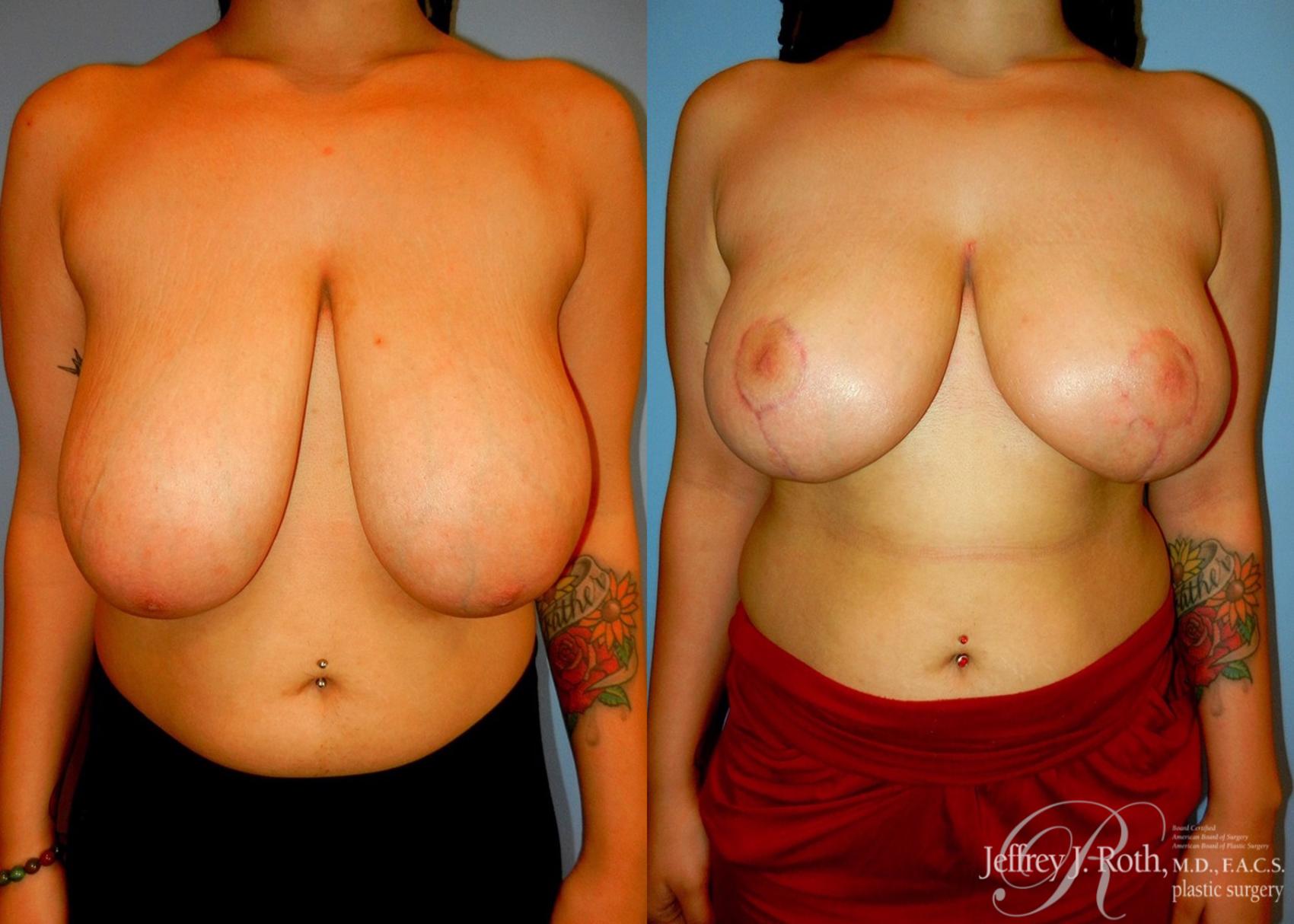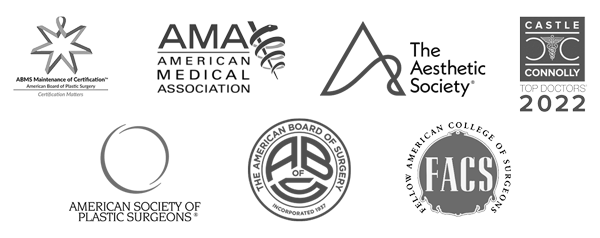Las Vegas Plastic Surgery: Jeffrey J. Roth M.D. F.A.C.S.
6140 S. Fort Apache Road, #100
Las Vegas, NV 89148
Phone: (702) 450-0777
Monday–Friday: 9 a.m.–5 p.m.
If you have overly large breasts, you’re no stranger to the physical and emotional discomfort they can cause. From back pain to difficulty exercising to chronic rashes and skin irritation, these unwanted effects can take a major toll over time.
When you’re ready to bring your breasts into proportion and make these issues a thing of the past, breast reduction surgery performed by board-certified Las Vegas plastic surgeon Dr. Jeffrey Roth is your answer.
Featured Breast Reduction Before & After Photos
WARNING:
This feature contains nudity. Please click OK to confirm you are at least 18 years of age and are not offended by such material.
What Is Breast Reduction?
Breast reduction is a surgical procedure that reduces the size of large breasts to relieve symptoms including back and neck pain, bra strap grooving, and rashes and other skin problems under the breast. Breast reduction may also help you feel more confident in your skin and achieve an appearance you feel great about.
How Is Breast Reduction Performed?
Once you are safely placed under general anesthesia, Dr. Roth will begin by making an incision. Through this incision, Dr. Roth will remove excess breast tissue and create a more proportional and attractive breast size and shape. He will then suture your incisions closed, being careful to minimize scarring as much as possible.
There are multiple incision options, including:
- Donut: This involves 2 circular incisions around your areola and results in one scar around the border of the areola.
- Lollipop or keyhole: An incision is made around the areola and connected to a vertical incision down the breast.
- Inverted T or anchor: This is similar to the lollipop incision but adds a horizontal incision along the lower crease of the breast.
Dr. Roth will recommend the best option for you based on your anatomy and goals.
How Much Does Breast Reduction Surgery Cost?
Breast reduction costs can vary based on several factors. One is the surgeon’s training and experience performing the procedure. Additional factors that contribute to cost include:
- The anesthesia fee
- Surgery center charges
- Pre-surgery tests
- Prescription medication and medical supplies for recovery
As you prepare for breast reduction surgery, you will receive information detailing the costs involved in your case. You may also be given information to help you explore financing options.
Is Breast Reduction Surgery Covered by Insurance?
Breast reduction surgery may qualify for insurance coverage in certain situations. If you are interested in finding out if you may qualify, we suggest that you contact your insurance company directly, as coverage may vary from one provider to another.
Generally, insurance companies provide coverage for breast reduction only when a woman has proven health problems caused by the size of her breasts. In such cases, the company may not only require pre-authorization for the procedure but also a documented history of the health problems caused by oversized breasts. An insurance company may require proof that nonsurgical therapies have been sought before they will consider authorizing breast reduction surgery. Individual companies may have unique criteria for surgical approval.
Meet Dr. Roth
Dr. Jeffrey Roth is a board-certified plastic surgeon and a Las Vegas local since 1977. Drawn to medicine by his innate desire to help others, he provides exceptionally natural-looking results, concierge-level service, and long-lasting connections to every person who walks through the doors of his practice, Las Vegas Plastic Surgery.
Get to Know Dr. Roth
Credentials You Can Trust:

Are There Risks to Breast Reduction Surgery?
Surgical procedures have common risks related to infection, anesthesia, and bleeding. Breast procedures have additional risks, which are low when surgery is performed by an experienced, board-certified plastic surgeon. These include:
- Breast asymmetry: This minor complication can be corrected through a revision surgery. However, patients who choose an experienced surgeon are less likely to experience noticeably disproportionate size after their reduction procedure.
- Uneven nipple position: Breast reduction trims the skin to lie smoothly over the smaller breast mound. This results in revised nipple shape and size, which could result in variance from one breast to the other. Again, an experienced surgeon expects tissue responses and works to prevent dramatic asymmetry.
- Change in breast sensation: Breast reduction that involves nipple grafting has a higher risk of temporary or prolonged change in sensation.
- Breastfeeding difficulty: Certain methods of breast reduction have a higher chance of disrupting milk ducts.
Reviews
Read what real people like you have shared about their experiences with Dr. Roth and his team.
Read Our ReviewsWhat To Expect During Your Breast Reduction Consultation
Dr. Roth will first listen to your concerns and goals. He will then gather a thorough medical history. Past medical events may impact your surgery, anesthesia, and recovery. Current issues such as medications, herbal remedies, allergies, smoking, drug use, and bleeding and scarring tendencies will be reviewed. Chronic issues (e.g. diabetes, high blood pressure, autoimmune disease) are also important.
Dr. Roth will examine you and will describe not only what he sees, but also how it relates to your appearance or other issues. Many items need to be taken into consideration, including your breast size, your chest size, and the current placement of the nipple/areola. The nipple and areola will have to be repositioned in most cases. He will then explain what might be done to improve each area medically or surgically. Scar placement is usually discussed, as well.
Some women may choose to combine their breast reduction with other procedures, such as a breast lift or tummy tuck, to achieve their ideal physique. While you may not wish to take advantage of every treatment that is available, we’ll make sure you are aware of all available options and what each might offer.
What Happens During the Pre-Procedure for Breast Reduction?
During your pre-op appointment, you will:
- Review your physical health. Your pre-op nurse will make sure you are safe to undergo surgery.
- Take “before” photos. These assist in the planning of the procedure and reviewing the improvement afterward. Postoperative photographs are generally taken 3 and 6 months after your procedure as well.
- Sign a surgical consent. This enumerates the risks of the procedure in detail. Some of these risks have been reviewed here but are also discussed at the consultation.
- Have appropriate prescriptions written (e.g., pain pills). This way, you will be able to take them when you return home.
- Discuss your post-op arrangements. You will need to arrange for someone to drive you to and from the surgery center. You cannot drive after surgery and for 10 days afterward. Recently sedated patients will not be placed into taxis for transport home. Medical transportation can be arranged in the event that you cannot find someone. It is mandatory to have someone stay with you for a few days after surgery, for your comfort and safety.
What Happens on the Day of Breast Reduction Surgery?
After arrival at the surgery center, the nursing staff will register you and have you change into the appropriate gown.
The choice of anesthetic will be made with input from you, your surgeon, and your anesthesiologist. Continuous monitoring of your vital signs is carried out throughout the operation.
There are different ways to perform breast reduction. These are determined by your anatomy, tissues, and goals.
The procedure usually takes a few hours, depending on the extent of your procedure. Appropriate arrangements should be made so that you’ll be observed for the first few nights after the procedure.
Is Breast Reduction Surgery Safe?
Studies indicate that breast reduction surgery ranks as one of the most satisfying of all plastic surgery procedures. Most complications that have been reported after breast reduction have been minor, not serious issues that require hospitalization. Case studies suggest that the level of risk for breast reduction correlates to the amount of reduction taking place. Smaller reductions have a complication rate of less than 5%. During your consultation, you can discuss your concerns about surgical risks based on your unique situation.
Is Breast Reduction Surgery Painful?
Post-surgical pain is largely dependent on the degree of reduction and the surgical technique used to perform the procedure. Regardless of technique, however, there is no pain during surgery involving general anesthesia. After surgery, expect the majority of pain to subside within a week. The first few days tend to be the worst in terms of discomfort. During that time, soreness and tenderness may be managed with prescription pain medication. After the first week, you may be ready to switch to an over-the-counter medicine for comfort control. Breast reduction recovery involves a lot of rest and avoidance of strenuous activities so that incisions and breast tissue can heal optimally.
What to Expect
Bringing your best look to life is as easy as 1-2-3.
1. Consultation
2. Pre-Op
3. Surgery
What Is Breast Reduction Recovery Like?
Remember that any surgical procedure requires a certain period of recovery from the surgery and anesthetic. Individuals vary, but it is possible to experience soreness, swelling, and bruising.
Returning Home
You will need to have someone drive you home from the surgery center. You should also have someone stay with you the first couple of days after you go home. You will also need someone to drive you to your visits to the Doctor. Remember, no driving for 10 days after the procedure. Any discomfort following breast reduction, is usually controlled well with the prescribed pain medication.
Surgical Dressings & Aftercare
The bra will act as the “dressing,” holding the implants and breasts in position. Ice and elevation (head up at 30°). This helps to decrease any bruising or swelling. You do not have to change the dressing until seen in the office at that time incision lines will be checked and you should be able to shower.
Returning to Work & Exercise
Although you will be up and around in a day or two, you should plan to take it a little slower the first week. Most patients can return to work in a few weeks. The final determination will be with you and Dr. Roth. You should avoid vigorous activity for a few weeks after surgery, as this will reduce the incidence of swelling or bleeding. Walking is encouraged. At each visit physical activity will be discussed.
Long-Term Healing
Some areas may be numb for weeks to months, and so heating pads and sunlamps are to be absolutely avoided. Sun exposure is discouraged for at least the first few months. Everyone responds differently to an operation. It may take some time for the healing process to let you accurately appreciate the operation. With proper peri-operative care, you should be able to maximize the healing process and help to achieve your goals.
A Few More Breast Reduction FAQs
Q: Who is a good candidate for breast reduction?
A: Women with breasts that are too large for their frame are usually good candidates for the surgery. A popular misconception is that only women with very large breasts are good candidates for breast reduction.
Q: What are the most common benefits of breast reduction surgery?
A: Most patients experience a relief in their neck and back pain. Often, women are able to maintain a more active lifestyle with more frequent exercise. Most women can now fit into normal-sized bras and blouses.
Q: Should I lose weight before getting a breast reduction?
A: It’s best to wait to get a breast reduction until you are at or near your goal weight. Significant weight loss after the surgery may affect your breast volume and shape, compromising your results.
Q: Can men get breast reduction surgery?
A: Male breast reduction is an effective treatment for gynecomastia, or excess breast tissue. It is one of the most popular plastic surgery procedures for men.
Q: How long after a breast reduction will I know my size?
A: While most swelling subsides after the first few weeks, it can take between 3 and 6 months for all residual swelling to subside. It’s best to wait until the 6-month mark to determine your new size and get fitted for your new bra size.
Q: Can you breastfeed after a breast reduction?
A: Certain surgical techniques can maintain your ability to breastfeed, while others may disrupt your milk ducts and cause difficulties. Let Dr. Roth know during the consultation process if you plan to have children in the future. He will select a technique with this in mind.
Q: What kind of bra is best to wear after breast reduction surgery?
A: After your surgery, you’ll need to wear a post-surgical bra for about 6 weeks. This soft, underwire-free bra will provide support and compression to promote circulation and minimize swelling. You can also wear a soft sports bra. Once your incisions have healed and your swelling has gone down, you can switch to whichever type of bra you feel most comfortable and confident in.
A New You Starts Now
For further information and answers to any questions you may have, please call us at (702) 450-0777 or request a consultation online. Our Las Vegas plastic surgery practice welcomes women interested in breast reduction surgery from throughout Henderson, NV, the greater Vegas area, and around the world.












